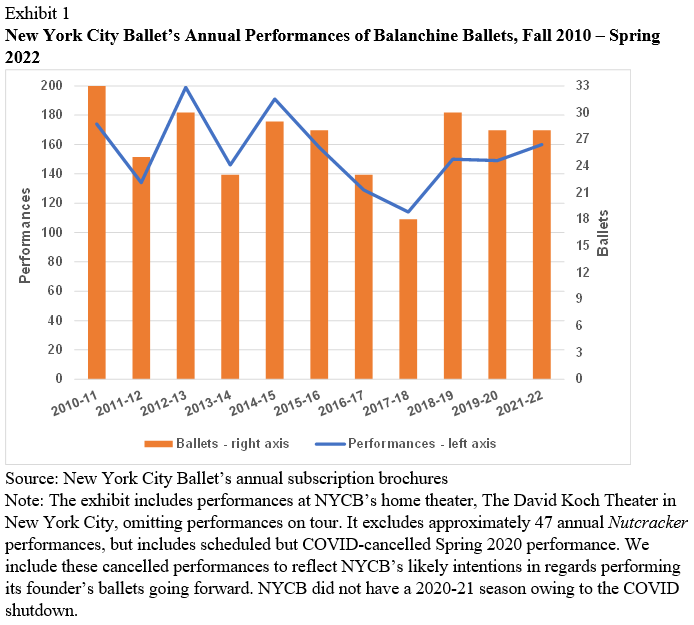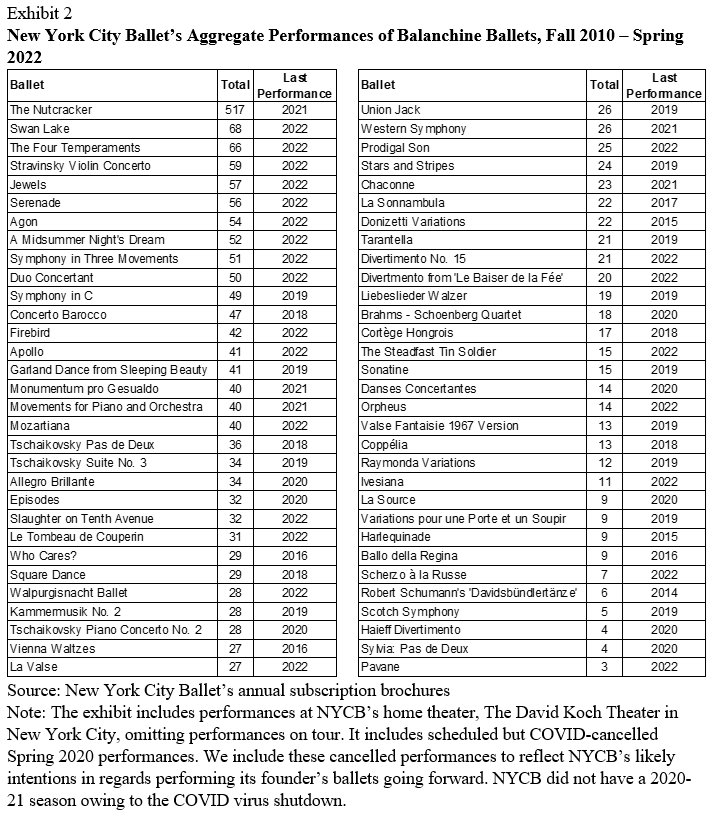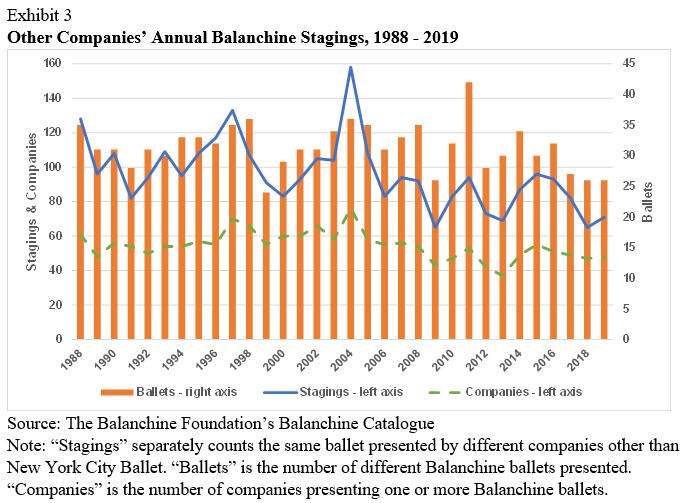The Status of George Balanchine’s Choreographic Legacy
This paper quantifies the status of George Balanchine’s choreographic legacy: how often his ballets are performed, how many companies perform his ballets, and how often specific ballets are performed. It also identifies Balanchine’s seldom-performed works and suggests measures to ensure the steps to these ballets are not forgotten and the ballets survive into the future. Seldom-Performed Ballets describes these 29 ballets.
Balanchine aficionados can be happy that the great choreographer’s ballets are regularly performed around the world. In 2019, New York City Ballet (NYCB) performed 30 of its founder’s ballets, including ones it had not performed in several years. That same year, 48 other ballet companies performed 26 different Balanchine ballets.
Yet only a fraction of Balanchine’s choreography is regularly performed and some of his ballets have not been performed in decades. Because ballets must be performed and committed to the muscle memories of dancers to survive, these artworks are in danger of being lost. No one entity can prevent this from happening. A cooperative and coordinated effort is required to preserve them.
This paper’s first section, “New York City Ballet,” tallies that company’s performances of Balanchine ballets. The paper’s next section, “Other Ballet Companies,” does the same for ballet companies other than NYCB. The paper’s third section “Ballets Not Performed in a Decade,” identifies 16 Balanchine works that might be in danger of being lost. The paper’s last section, “Preserving Balanchine’s Legacy,” suggests actions various entities can take to safeguard the master’s ballets. Seldom-Performed Ballets provides detail on 29 Balanchine ballets.
New York City Ballet
NYCB is the most important curator of George Balanchine’s oeuvre. In an average year, NYCB puts on 155 performances of 27 different Balanchine ballets, not counting 47 performances of Balanchine’s Nutcracker. Exhibit 1 shows the number of Balanchine ballets and their performances each season beginning Fall 2010 at NYCB’s home theater in New York City. The exhibit excludes approximately 47 annual Nutcracker performances, but includes scheduled but COVID-cancelled Spring 2020 performances. We include cancelled performances to reflect NYCB’s likely intentions in regards performing its founder’s ballets going forward. After declining for three seasons, 2015-16 to 2017-18, the number of Balanchine ballets and their performances returned to their long-run averages beginning in 2018-19.
Over 2010-11 through 2021-22 annual seasons, NYCB performed (or would have performed but for COVID) 61 of its founder’s ballets at its home theater. This amounts to an astounding 2,221 performances, one-quarter of which were performances of The Nutcracker. Exhibit 2 shows the ballets and number of performances.
How do these 61[1] ballets that NYCB performed compare to Balanchine’s total body of work? The Balanchine Foundation’s Balanchine Catalogue[2] lists 449 ballets, including significant revisions of earlier ballets. But in making a comparison, we want to identify only those ballets of noteworthy artistic merit that can still be taught to dancers and performed. We assume that the 82 ballets the Balanchine Trust lists on its website[3] meet both criteria. We add 11 other ballets, not listed on the Trust website, that have been performed since 1995 by either NYCB or another ballet company. This yields 93 ballets that seem both worthy and capable of being staged. So, the 61 ballets that NYCB performed or was scheduled to perform are almost two-thirds of Balanchine’s noteworthy and available ballets.
Exhibit 2 also includes the year that NYCB last performed the Balanchine ballet. Looking at the number of times NYCB performed a ballet and the last year it performed a ballet, one can get a sense for the company’s programming of seldom-performed ballets. Ballo della Regina, Harlequinade, and Robert Schumann's 'Davidsbündlertänze' are seldom-performed works that have also not been performed in a while. None of the ballets was performed more than nine times in this 12-year period, and none was performed more recently than 2016.
In contrast, Exhibit 2 shows that NYCB increased its presentation of seldom-seen ballets in 2019. In calendar years 2019-20, NYCB presented Valse Fantaisie, which it had not presented in eight years; La Source, nine years; Scotch Symphony, ten years; and Haieff Divertimento, 25 years. In 2022, NYCB plans to present an excerpt from Ivesiana, which it has not presented in nine years; Scherzo à la Russe, 10 years; and Pavane, over 12 years. An eighth seldom-seen ballet, Sylvia Pas de Deux, which NYCB has not performed for 26 years, was cancelled in 2020 owing to the COVID shutdown.
In summary, over the last 12 years, NYCB has performed 61 Balanchine ballets, or two-thirds of the noteworthy Balanchine ballets likely able to be performed. Beginning in 2018-19, it increased the number of Balanchine ballets and the number of performances of Balanchine ballets back up to historic averages. That same year, it began putting on more of the master’s seldom-performed works. We don’t think there is a lot more NYCB can do to perform Balanchine ballets; it seems to be running at near-capacity in that regard. For both artistic and commercial reasons, the company can’t forego other established works in its repertoire and it can’t stop commissioning new work. It seems that to make significant progress in getting more Balanchine ballets on stage, we have to look to other ballet companies.
Other Ballet Companies
We databased information compiled by the Balanchine Trust and presented by the Balanchine Foundation in its Balanchine Catalogue.[4] In this paper, we focus on 1988-2019; the first full year the Trust was in operation and the last year performances were unaffected by COVID. The Balanchine Catalogue reports a ballet’s “stagings,” the presentation of a particular ballet by a particular company in a particular year, without respect to how many times the company performed the ballet that year.
The trend outside NYCB, 1988 to 2019, is fewer stagings of Balanchine ballets by fewer companies. In 1988, there were 128 stagings. In 2019, there were 71, a 45% decline. In 1988, 61 companies staged at least one Balanchine ballet. In 2019, 48 companies did so, a 21% decline.
The range of Balanchine ballets also shrank. In 1988, companies other than NYCB performed 35 different ballets. In 2019, “other companies” performed 26 different ballets, a 26% decline. Exhibit 3 shows, for each year, the number of stagings, the number of companies presenting one or more Balanchine ballets, and the number of different Balanchine ballets presented.
The 100th anniversary of Balanchine’s birth in 2004 was the high point of stagings. Seventy-six companies staged 36 different ballets for a total of 158 stagings. Exhibit 4 compares average annual statistics before and after the 2004 centennial. Average annual stagings decreased 19%, to 84 from 103. The average number of companies staging ballets decreased 14%, to 50 from 58. The average number of different ballets staged declined only 1%, to 31.1 from 31.5.
In the decade 2010-19, 148 companies staged 64 ballets, for a total of 822 stagings. Stagings were concentrated among ballets, as the ten most-staged ballets accounted for 59% of all stagings and the 17 most-staged ballets made up 74% of all stagings. Exhibit 5 shows the Balanchine ballets staged 2010-19 by companies other than NYCB and the number of times they were staged.
Among the ballets staged by other companies 2010-19 are 16 ballets that were not performed or scheduled to be performed by NYCB 2010-22.[5] Exhibit 6 shows the ballets, the last year the ballets were staged, and the companies staging the ballets.
Going forward, Balanchine stagings will be negatively affected by the closure of companies that previously performed the choreographer’s ballets. At least 7% of stagings 1988-2019 were from companies now defunct, mostly from the Suzanne Farrell and Silicon Valley ballet companies. Other companies greatly decreased their number of stagings, 1988-2003 to 2005-2019. Ten companies, active in the earlier period, had 305 fewer stagings in the later period.
It seems that there is great scope for companies other than NYCB to revive seldom-performed Balanchine ballets. They already are doing so, as witnessed by the 16 seldom-performed Balanchine ballets they put on 2010-19. There are also a lot of “other companies” potentially available to perform Balanchine’s work: dancer.com lists over 400 ballet companies worldwide!
Ballets Not Performed in a Decade
We’ve previously estimated in this paper that there are 93 Balanchine ballets of noteworthy artistic merit that are still able to be taught to dancers and performed. From 2010 to 2022, NYCB and other companies have performed 77 of these. That leaves 16 ballets that have not been performed in the last decade and seem in danger of being lost, shown in Exhibit 7.
We provide detail on these 16 ballets and 13 ballets that are also rarely performed in Seldom-Perform Ballets.
Preserving Balanchine’s Legacy
To the enthusiast, Balanchine’s ballets are joyful, life-affirming, and inspiring. It is natural to want others to experience them and dispiriting to contemplate that some of Balanchine’s significant artworks might be lost. The popularity of certain 19th century ballets suggests that maintaining Balanchine’s 20th century oeuvre is realistic. Ballets premiering as far back as 1841 are performed by many companies throughout the world. Examples are Giselle, Le Corsaire, Don Quixote, Coppélia, Swan Lake, La Bayadère, The Sleeping Beauty, The Nutcracker, and Raymonda.
However, even the most fervent Balanchine fan might wonder whether his seldom-performed works are worth reviving. One might assume that these ballets are inferior to ones performed regularly. But this is often an incorrect assumption to make. Such ballets as La Source, Sonatine, Valse Fantaisie, Symphonie Concertante, Harlequinade and Robert Schumann’s ‘Davidsbündlertänze’ have been revived to critical acclaim after long absences from the stage.
Maintaining Balanchine’s worthy ballets, indeed reconstructing some of the neglected ones, will take a cooperative effort from The Balanchine Trust, The Balanchine Foundation, ballet companies, and ballet patrons. No single entity, can accomplish this mission on its own. What follows are thoughts on the contributions different parties can make to achieve this goal.
The Foundation can identify significant Balanchine ballets that are underperformed and raise an alarm for those in danger of being lost. It can advocate for these ballets and recruit interest in them among ballet companies and patrons. The Foundation can produce a catalog of revival candidates targeted to artistic directors and ballet patrons to increase interest in and funding for these ballets. It can set best practices for the video recording of dance specifically to help répétiteurs stage ballets in the future.
The Trust can offer discounted or free licensing of ballets that are in danger of being lost owing to neglect. It makes commercial sense for the owners of Balanchine’s ballets to accept lower fees to save their ballets from extinction.
Ballet patrons can support the staging of seldom-performed ballets. They can look with particular favor on proposals incorporating:
co-productions, where multiple companies share production costs;
unique publicity, educational, and audience development strategies;
for ballets where such is missing, the video recording of the work to facilitate future stagings.
Ballet companies do the actual work of keeping ballets alive. They can share resources and the costs of producing Balanchine ballets. An example of this occurred in 2010-11, when the Boston, Pacific Northwest, Dresden, and San Francisco companies staged Coppélia and divided the cost of répétiteur, scenery, and costumes. If needed or helpful, larger companies can lend their stars to smaller companies to perform principal roles.
Ballet companies can also take advantage of fund-raising opportunities unique to staging seldom-performed ballets. Appeals can be made to balletomanes who appreciate Balanchine’s legacy and are alarmed that some of it might become lost. By sponsoring a Balanchine revival, they contribute to saving a work of art by the master they love and leave their own legacy. Another fund-raising appeal is to film makers and sport broadcasters for help in video recording a ballet in such a way as to facilitate its staging in the future.
Staging a seldom-performed ballet also provides the company doing so with unique publicity opportunities around the themes of the fragility of the art form, the apostolic succession of ballet from generation to generation, and the use of technology in the service of art. This New York Times article on the restoration of Balanchine’s Cotillon is an example of what is achievable. The process of reviving the ballet is also a documentary film idea.
Summary
New York City Ballet performed 61 different Balanchine ballets 2010-22. Since 2019, it has increased the number of Balanchine ballets and performances to long-term norms. Since 2019, it has also revived several of the master’s seldom-performed works. It does not seem likely that NYCB can significantly increase it presentation of Balanchine ballets.
Meanwhile, the trend outside NYCB, 1988 to 2019, is fewer stagings of Balanchine ballets by fewer companies. Still, other companies staged 16 Balanchine ballets over 2010-2019 that NYCB did not present. The sheer number of ballet companies around the world suggests that all seldom-performed Balanchine ballets of merit could be revived by them and kept in dancers’ memories.
We identified 29 seldom-performed ballets, among the 93 ballets either listed as available on the Trust website or performed since 1995. Some of these seldom-performed works have not been performed in a decade. These ballets are detailed in the Seldom-Performed Ballets.
We suggested actions that various stakeholders could take to ensure that Balanchine’s worthy ballets are preserved. The Foundation can identify significant seldom-performed works and advocate on their behalf. The Trust can discount licensing fees for these ballets. Patrons can fund the staging of these ballets. Ballet companies can employ unique fund-raising and publicity campaigns on behalf of seldom-performed ballets.
——————
[1] We list Sylvia: Pas de Deux in Exhibit 2, but its performances were cancelled owing to the COVID shutdown.
[2] The Balanchine Foundation was set up after the master’s death to promote his legacy with “research, ballet reconstructions, publications, lectures and videos.” Its catalogue is at https://balanchine.org/catalogue-page/catalogue-main-archive/
[3] The Balanchine Trust “is responsible for the business of licensing Balanchine’s ballets.” Its list of ballets is at https://www.balanchine.com/BalletsAlph.
[4] In our research, we found examples of Balanchine ballet performances not included in the Balanchine Catalogue. We present the time series analyses in Exhibits 3 and 4 without adjustment to Balanchine Catalogue data and assume that the Trust’s inclusion criteria make the data comparable year-to-year even if it is not precisely accurate.
[5] We found reviews of Balanchine ballet performances not included in the Balanchine Catalogue and include these performances in Exhibit 6, Exhibit 7, and Seldom-Performed Ballets.
Copyright © 2021 Balanchine Patrons. All rights reserved. Short excerpts may be republished if Balanchine Patrons credited or linked.







